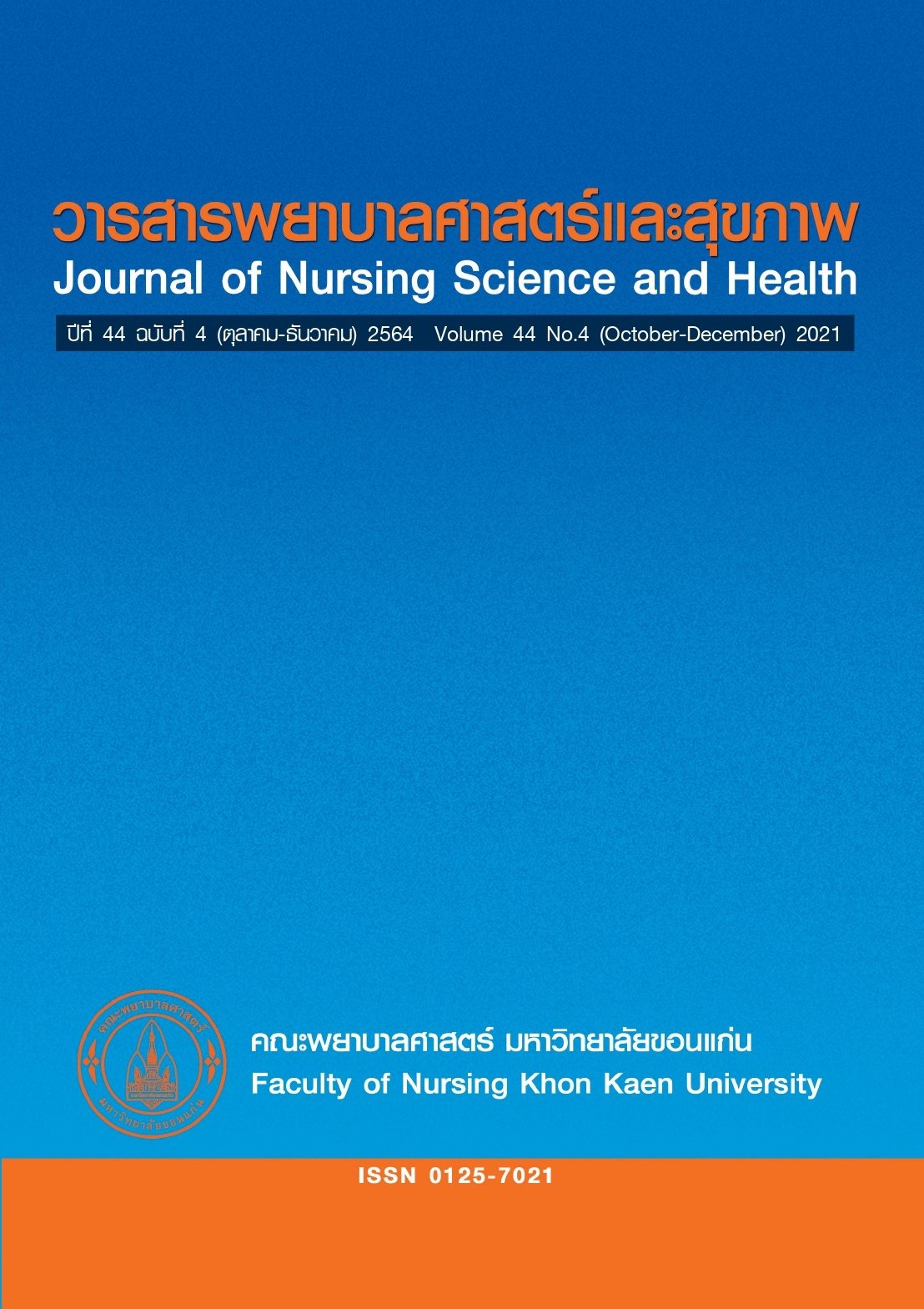การพัฒนาแนวปฏิบัติการตรวจนับวัสดุผ่าตัดสำหรับผู้ป่วยที่เข้ารับการผ่าตัดใหญ่ห้องผ่าตัด
คำสำคัญ:
แนวปฏิบัติ, การตรวจนับวัสดุผ่าตัด, การผ่าตัดใหญ่บทคัดย่อ
ปัญหาที่มีโอกาสเกิดขึ้นหลังการผ่าตัดคือ วัสดุผ่าตัดตกค้างในร่างกายผู้ป่วย การวิจัยครั้งนี้ ประยุกต์จากแนวคิดการพัฒนาแนวปฏิบัติคลินิกของสภาวิจัยด้านการแพทย์และสุขภาพแห่งชาติของประเทศออสเตรเลีย (National Health and Medical Research Council, 1998) มีวัตถุประสงค์ เพื่อ 1.พัฒนาแนวปฏิบัติการตรวจนับวัสดุผ่าตัด สำหรับผู้ป่วยที่รับการผ่าตัดใหญ่ และ 2.วัดผลลัพธ์ของการนำแนวปฏิบัติไปใช้ กลุ่มตัวอย่างเลือกแบบเฉพาะเจาะจง ประกอบด้วย 3 กลุ่ม ได้แก่ พยาบาล 27 คน แพทย์ 9 คน และผู้ป่วยผ่าตัดใหญ่ 21 คนที่โรงพยาบาลระดับตติยภูมิแห่งหนึ่งในภาคตะวันออกเฉียงเหนือ ระยะเวลาดำเนินการวิจัย ตุลาคม 2560 ถึงมิถุนายน 2561 รวมระยะเวลา 9 เดือน เครื่องมือที่ใช้เก็บรวบรวมประกอบด้วย แบบสอบถามความเป็นไปได้ของการใช้แนวปฏิบัติ แบบสอบถามสำรวจปัญหาการตรวจนับ แบบบันทึกรายงานความเสี่ยงวัสดุผ่าตัดตกค้างในร่างกายผู้ป่วย แบบบันทึกอุบัติการณ์เครื่องมือผ่าตัดและของมีคมที่ติดไปกับผ้าเปื้อน และแบบประเมินความพึงพอใจ วิเคราะห์ข้อมูลด้วยสถิติบรรยาย ผลการวิจัยพบว่า การตรวจนับวัสดุผ่าตัดมีความเป็นไปได้โดยเฉลี่ยร้อยละ 99.64 ความพึงพอใจในการใช้แนวปฏิบัติของพยาบาลภาพรวมอยู่ในระดับมากที่สุด แพทย์ความพึงพอใจในการใช้แนวปฏิบัติภาพรวมอยู่ในระดับมาก หลังใช้แนวปฏิบัติพบว่า อุบัติการณ์ วัสดุผ่าตัดตกค้างในร่างกายผู้ป่วย เท่ากับ 0 และจำนวนเครื่องมือผ่าตัดและของมีคมติดไปกับผ้าเปื้อนที่หน่วยงานซักฟอกในปี พ.ศ.2558, 2559 และ2560 เป็นจำนวน 31 ชิ้น 34 ชิ้น และ 40 ชิ้น ตามลำดับ
เอกสารอ้างอิง
Rose J, Weiser TG, Hider P, Wilson L, Gruen RL, Bickler SW, et al. Estimated need for surgery worldwide based on prevalence of diseases: A modelling strategy for the WHO global health estimate. Lancet Glob Health 2015; 3(Suppl2): S13-20.
Department of Medical Service, Ministry of Public Health Medical service statistics report. Bangkok: Information and communication technology center; 2013. (in Thai)
Auprasert K. Nurses and risk management in surgical patients. Administration risk in the operating room: Bangkok: Ramathibodi Nursing Alumni Association; 2003: 55-72. (in Thai)
Phutharangsi S, Seephom S. The relationship between selected factors and perioperative nurses’ competencies in Thailand. JRTAN 2017; 18: 94–103. (in Thai)
Permpetch R, Butsripoom B. The role of operating room nurses: Providing information on visits to patients before and after surgery. Rama Nurse 2015;2 (1): 10-9. (January-April 2016) (in Thai)
Fencl JL. Guideline implementation: Prevention of retained surgical items. AORN J 2016; 104(1): 37–48.
Goldberg JL, Feldman DL. Implementing AORN recommended practices for prevention of retained Surgical Items. AORN J 2012; 95(2): 205–19.
Stawicki SPA, Moffatt-Bruce SD, Ahmed HM, Anderson HL, Balija TM, Bernescu I, et al. Retained surgical items: A problem yet to be solved. J Am Coll Surg 2013;216(1):15–22.
Butler M, Ford R, Boxer E, Sutherland-Fraser S. Lessons from the field: An examination of count errors in the operating theatre. Acorn 2010;23(3):6–16.
Cima RR, Kollengode A, Garnatz J, Storsveen A, Weisbrod C, Deschamps C, et al. Incidence and characteristics of potential and actual retained foreign object events in surgical patients. J Am Coll Surg 2008;207(1):80–7.
Moffatt-Bruce SD, Ellison EC, Anderson HL, Chan L, Balija TM, Bernescu I, et al. Intravascular retained surgical items: A multicenter study of risk factors. J Surg Res. 2012;178(1):519–23.
Rowlands A. Risk factors associated with incorrect surgical counts. AORN J 2012;96(3): 272–84.
Moffatt-Bruce SD, Cook CH, Steinberg SM, Stawicki SP. Risk factors for retained surgical items: A meta-analysis and proposed risk stratification system. J Surg Res 2014;190(2): 429–36.
Naidoo R, Singh B. Gossypiboma-the retained surgical swab: An enduring clinical challenge. S Afr J Obstet Gynaecol 2016; 22(1): 29–32.
Joint Commission. Preventing unintended retained foreign objects. Sentinel Event Alert 2013; (51): 1–5.
Steelman VM, Shaw C, Shine L, Hardy-Fairbanks AJ. Retained surgical sponges: A descriptive study of 319 occurrences and contributing factors from 2012 to 2017. Patient Saf Surg 2018; 12(1): 1–9.
Saengbunruangkul C. The development of clinical nursing practice guideline for postoperative pain management in critically ill child using evidence base practice. [Dissertation]. Khonkaen: Khonkaen University; 2009. (in Thai)
Tchangai B, Tchaou M, Kassegne I, Simlawo K. Incidence, root cause, and outcomes of unintentionally retained intraabdominal surgical sponges: A retrospective case series from two hospitals in Togo. Patient Saf Surg 2017;11(1):1–8.
Somrang A. Development of practice guideline for counting instruments, Sharps and sponges of personnel in operating room, Song Hospital, Phrae province [Independent Study]. Khonkaen: Khonkaen University; 2006. (in Thai)
NHMRC. A guide to the development, implementation and evaluation of clinical practice guidelines; 1998. Available from: http://www.health.gov.au retrieved on 30/4/2004
Fineout-Overholt E, Melnyk BM, Schultz A. Transforming health care from the inside out: Advancing evidence-based practice in the 21st century. J Prof Nurs 2005;21(6):335–44.
Stiller RJ, Thompson T, Ivy MJ. Preventing retained foreign objects in ob/gyn surgery. Contemp Ob Gyn 2010; 55(6): 22–8.
Denise F, Beck TC. Nursing research: Generating and assessing evidence for nursing practice. 10th ed. Philadelphia: Walters Kluwer Health; 2017.
The Joanna Briggs Institute. Reviewers’ Manual 2014 edition. Australia: Solito Fine Colour Printers; 2014. Available from: http://www.Joannabriggs.org/assets/docs/ sumari/reviewer smanual-2014.pdf.
ดาวน์โหลด
เผยแพร่แล้ว
รูปแบบการอ้างอิง
ฉบับ
ประเภทบทความ
สัญญาอนุญาต
วารสารพยาบาลศาสตร์และสุขภาพเป็นเจ้าของลิขสิทธิ์ในการเผยแพร่ผลงานที่ตีพิมพ์ห้ามผู้ใดนำบทความที่ได้รับการตีพิมพ์ในวารสารพยาบาลศาสตร์และสุขภาพไปเผยแพร่ในลักษณะต่าง ๆ ดังนี้ การนำบทความไปเผยแพร่ออนไลน์ การถ่ายเอกสารบทความเพื่อกิจกรรมที่ไม่ใช่การเรียนการสอน การส่งบทความไปตีพิมพ์เผยแพร่ที่อื่น ยกเว้นเสียแต่ได้รับอนุญาตจากวารสารพยาบาลศาสตร์และสุขภาพ



